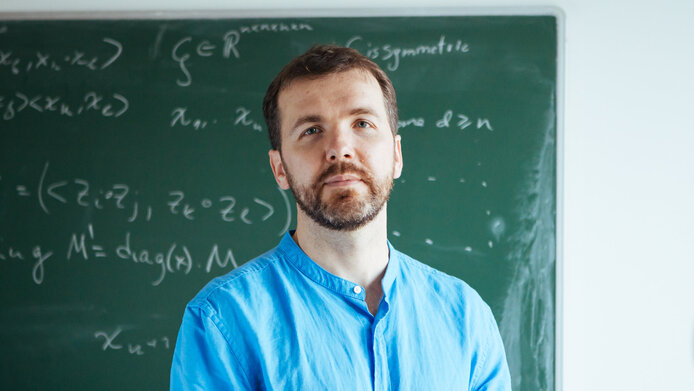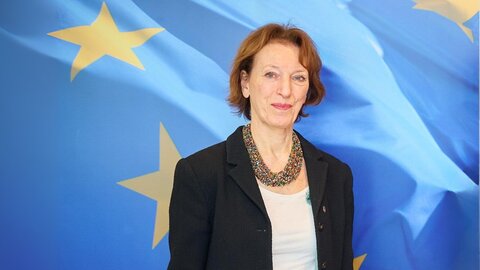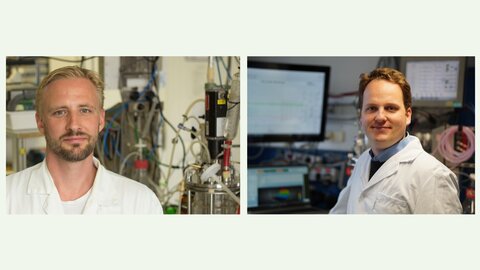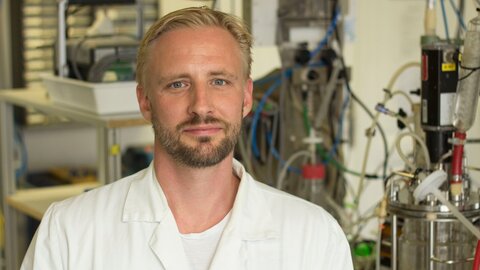A new glance into the black box

Mr. Malitskyi, what role do optimization problems play in our world?
Yurii Malitskyi: In general, people try to find the optimal solution to their problems. Let's say I want to build a bridge. In that case I will have requirements for the structure, for instance that it should be as safe as possible, or as cheap as possible to build.
Achieving these goals is an optimization problem. Or take a delivery company: it would not be wise to have the delivery vehicle cross the city center unnecessarily to bring something to a company in the suburbs. You see, people are constantly solving optimization problems. Incidentally, nature does the same, even if we don't always understand how.
Nowadays we are increasingly using the help of computers for such problems. How does that work?
Malitskyi: Most problems are too difficult to solve just off the top of one’s head. That's why we need algorithms, i.e. simple calculation instructions that approach the goal step by step. These strategies can be translated into the language of mathematics and applied by computers and software.
Personal details
Yurii Malitskyi completed his doctorate at the University of Kiev, followed by research at Graz University of Technology, the University of Göttingen and EPF Lausanne. He then was appointed assistant professor at the University of Linköping in Sweden. In 2023, he was appointed as an assistant professor for computer-aided optimization at the University of Vienna. Accordingly, Malitskyi’s research focus is on optimization algorithms.
There are numerous examples of such algorithms, but basically the goal is always to minimize or maximize a function. Since we are talking about computers: you won’t be surprised to hear that our research now places a major focus on artificial intelligence, since an essential step in machine learning is also an optimization problem.
In the context of your project, you are addressing continuous optimization problems. What does that mean?
Malitskyi: In continuous optimization problems, the solution can be a real number. The solution for discrete optimization problems, on the other hand, can only be fixed values, such as zero or one. To give you an example of the latter: a circuit board with many switches, where the current is to be maximized. In this case, the solution you are looking for can only contain discrete values, as each switch is either open or not.
In fact, as a rule such discrete problems cannot be solved, which means that all you can do is try out each possibility in turn to find the optimum. If you have a great number of alternatives, this can take virtually an infinite amount of time. However, there are cases where continuous optimization can be used to approximate the solution to a discrete problem.
But for you, the solution to a specific problem is not the most important thing, is it?
Malitskyi: That’s right, the aim is not just to solve a problem, but quite generally to construct new algorithms, investigate their theoretical properties and apply them in the end. Of course, many people won't care about the theory; as long as the algorithm works they are content. But as mathematicians, we want to understand algorithms and study their properties.
The black-box assumption plays a central role in this context: in our research, we assume that we have no access to the function that is to be optimized. All we have is a black box that spits out information, such as function values or the derivative at some points – whatever it may be. Based on this limited information we construct algorithms.
But it is precisely this black box that you want to look into.
Malitskyi: Yes, because this black box contains many different functions with different properties that appear in different applications. So I think it's time to do better than this black box and use information about the functions’ structures to explore what the best algorithms are for smaller classes of functions and why we can't do better.
About the project
Yurii Malitskyi uses the mathematical structure of various optimization problems in order to find better algorithms that arrive at solutions more quickly and also give him a deeper understanding of the mathematical properties of the algorithms. To this end, he has to abandon the black-box assumption that is normally applied to functions in optimization problems. His approach promises progress in basic research and areas of application such as artificial intelligence.
Adaptive algorithms are a case in point: picture a function as a landscape in which you want to find a mountain or a valley. Once you place an algorithm in this landscape, it will move towards the maximum or minimum step by step, until you reach the desired point. An adaptive algorithm would use the local structure of the function to take larger steps and arrive at the destination faster. And faster algorithms save resources and reduce costs.
What impact would this have on artificial intelligence?
Malitskyi: Our project is not going to change the entire field of AI. Given, however, that the most complex step in machine learning is an optimization problem, it is important to look for new algorithms and understand their properties. For our purposes, we are primarily interested in the mathematical aspects of optimization.
What happens now, after the START Award?
Malitskyi: The lion’s share of the funds will be used to pay staff costs, including those for three PhD students, as well as conference and travel costs. But the award also gives me time to develop ideas and find the right team. And as any researcher knows: time is more valuable than money.
The FWF START Award
The START program of the Austrian Science Fund (FWF) is aimed at outstanding young researchers, giving them the opportunity to plan their research in the long term and with a high degree of financial security. It is endowed with up to €1.2 million and is one of Austria’s most prestigious and most highly endowed awards alongside the FWF Wittgenstein Award.





